VEGF/neuropilin-2 regulation of Bmi-1 and consequent repression of IGF-IR define a novel mechanism of aggressive prostate cancer
- PMID: 22777769
- PMCID: PMC4205964
- DOI: 10.1158/2159-8290.CD-12-0085
VEGF/neuropilin-2 regulation of Bmi-1 and consequent repression of IGF-IR define a novel mechanism of aggressive prostate cancer
Abstract
We show that the VEGF receptor neuropilin-2 (NRP2) is associated with high-grade, PTEN-null prostate cancer and that its expression in tumor cells is induced by PTEN loss as a consequence of c-Jun activation. VEGF/NRP2 signaling represses insulin-like growth factor-1 receptor (IGF-IR) expression and signaling, and the mechanism involves Bmi-1-mediated transcriptional repression of the IGF-IR. This mechanism has significant functional and therapeutic implications that were evaluated. IGF-IR expression positively correlates with PTEN and inversely correlates with NRP2 in prostate tumors. NRP2 is a robust biomarker for predicting response to IGF-IR therapy because prostate carcinomas that express NRP2 exhibit low levels of IGF-IR. Conversely, targeting NRP2 is only modestly effective because NRP2 inhibition induces compensatory IGF-IR signaling. Inhibition of both NRP2 and IGF-IR, however, completely blocks tumor growth in vivo.
Figures

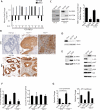
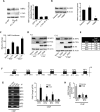
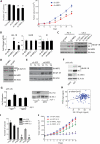
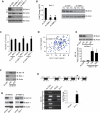
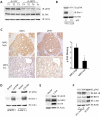
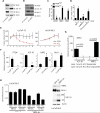
Similar articles
-
Hypoxia induces tumor and endothelial cell migration in a semaphorin 3F- and VEGF-dependent manner via transcriptional repression of their common receptor neuropilin 2.Cell Adh Migr. 2011 May-Jun;5(3):266-75. doi: 10.4161/cam.5.3.16294. Epub 2011 May 1. Cell Adh Migr. 2011. PMID: 21610314 Free PMC article.
-
Therapeutic targeting of neuropilin-2 on colorectal carcinoma cells implanted in the murine liver.J Natl Cancer Inst. 2008 Jan 16;100(2):109-20. doi: 10.1093/jnci/djm279. Epub 2008 Jan 8. J Natl Cancer Inst. 2008. PMID: 18182619
-
Therapeutic blocking of VEGF binding to neuropilin-2 diminishes PD-L1 expression to activate antitumor immunity in prostate cancer.Sci Transl Med. 2023 May 3;15(694):eade5855. doi: 10.1126/scitranslmed.ade5855. Epub 2023 May 3. Sci Transl Med. 2023. PMID: 37134151
-
Interaction of IGF signaling and the androgen receptor in prostate cancer progression.J Cell Biochem. 2006 Oct 1;99(2):392-401. doi: 10.1002/jcb.20929. J Cell Biochem. 2006. PMID: 16639715 Review.
-
Role of Neuropilin-2-mediated signaling axis in cancer progression and therapy resistance.Cancer Metastasis Rev. 2022 Sep;41(3):771-787. doi: 10.1007/s10555-022-10048-0. Epub 2022 Jul 1. Cancer Metastasis Rev. 2022. PMID: 35776228 Free PMC article. Review.
Cited by
-
Emerging Role of IGF-1 in Prostate Cancer: A Promising Biomarker and Therapeutic Target.Cancers (Basel). 2023 Feb 17;15(4):1287. doi: 10.3390/cancers15041287. Cancers (Basel). 2023. PMID: 36831629 Free PMC article. Review.
-
Neuropilin-2 acts a critical determinant for epithelial-to-mesenchymal transition and aggressive behaviors of human head and neck cancer.Cell Oncol (Dordr). 2024 Apr;47(2):497-511. doi: 10.1007/s13402-023-00878-7. Epub 2023 Oct 3. Cell Oncol (Dordr). 2024. PMID: 37787967
-
The emerging role of class-3 semaphorins and their neuropilin receptors in oncology.Onco Targets Ther. 2014 Sep 24;7:1663-87. doi: 10.2147/OTT.S37744. eCollection 2014. Onco Targets Ther. 2014. PMID: 25285016 Free PMC article. Review.
-
Downregulated miR-495 [Corrected] Inhibits the G1-S Phase Transition by Targeting Bmi-1 in Breast Cancer.Medicine (Baltimore). 2015 May;94(21):e718. doi: 10.1097/MD.0000000000000718. Medicine (Baltimore). 2015. PMID: 26020378 Free PMC article.
-
Pancancer Analysis of Neurovascular-Related NRP Family Genes as Potential Prognostic Biomarkers of Bladder Urothelial Carcinoma.Biomed Res Int. 2021 Apr 15;2021:5546612. doi: 10.1155/2021/5546612. eCollection 2021. Biomed Res Int. 2021. Retraction in: Biomed Res Int. 2024 Mar 20;2024:9802197. doi: 10.1155/2024/9802197. PMID: 33937395 Free PMC article. Retracted.
References
-
- Siegel R, Ward E, Brawley O, Jemal A. Cancer statistics, 2011: The impact of eliminating socioeconomic and racial disparities on premature cancer deaths. CA Cancer J Clin. 2011;61:212–36. - PubMed
-
- Bachelder RE, Crago A, Chung J, Wendt MA, Shaw LM, Robinson G, et al. Vascular endothelial growth factor is an autocrine survival factor for neuropilin-expressing breast carcinoma cells. Cancer Res. 2001;61:5736–40. - PubMed
-
- Lichtenberger BM, Tan PK, Niederleithner H, Ferrara N, Petzelbauer P, Sibilia M. Autocrine VEGF signaling synergizes with EGFR in tumor cells to promote epithelial cancer development. Cell. 2010;140:268–79. - PubMed
-
- Beck B, Driessens G, Goossens S, Youssef KK, Kuchnio A, Caauwe A, et al. A vascular niche and a VEGF-Nrp1 loop regulate the initiation and stemness of skin tumours. Nature. 2011;478:399–403. - PubMed
Publication types
MeSH terms
Substances
Grants and funding
LinkOut - more resources
Full Text Sources
Other Literature Sources
Medical
Molecular Biology Databases
Research Materials
Miscellaneous

